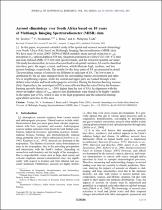 ResearchSpace
ResearchSpace
Aerosol climatology over South Africa based on 10 years of Multiangle Imaging Spectroradiometer (MISR) data
JavaScript is disabled for your browser. Some features of this site may not work without it.
- ResearchSpace
- →
- Research Publications/Outputs
- →
- Journal Articles
- →
- View Item
| dc.contributor.author |
Tesfaye, M

|
|
| dc.contributor.author |
Sivakumar, V

|
|
| dc.contributor.author |
Botai, J

|
|
| dc.contributor.author |
Tsidu, M

|
|
| dc.date.accessioned | 2012-11-19T15:21:16Z | |
| dc.date.available | 2012-11-19T15:21:16Z | |
| dc.date.issued | 2011-10 | |
| dc.identifier.citation | Tesfaye, M, Sivakumar, V, Botai, J, and Tsidu, M. Aerosol climatology over South Africa based on 10 years of Multiangle Imaging Spectroradiometer (MISR) data. Journal of Geophysical Research: Atmospheres, vol. 116, DOI: 10.1029/2011JD016023, 17pp | en_US |
| dc.identifier.issn | 0148-0227 | |
| dc.identifier.uri | http://www.agu.org/pubs/crossref/2011/2011JD016023.shtml | |
| dc.identifier.uri | http://hdl.handle.net/10204/6332 | |
| dc.description | Published in Journal of Geophysical Research: Atmospheres, vol. 116, DOI: 10.1029/2011JD016023. Copyright: 2012 American Geophysical Union. | en_US |
| dc.description.abstract | In this paper, the authors present a detailed study of the spatial and seasonal aerosol climatology over South Africa (SA), based on Multiangle Imaging Spectroradiometer (MISR) data. They've have used 10 years (2000–2009) of MISR monthly mean aerosol extinction (text), absorption (ta) optical depths at 558 nm, Angstrom exponents in visible (VIS; 446–672 nm) and near-infrared (NIR; 672–866 nm) spectral bands, and the extracted spectral curvature. The study has shown that, in terms of aerosol load level spatial variation, SA can be classified into three parts: the upper, central, and lower, which illustrate high, medium, and low aerosol loadings, respectively. The results for the three parts of SA are presented in detail. The prevailing sources of aerosols are different in each part of SA. The lower part is dominated by the air mass transport from the surrounding marine environment and other SA or neighboring regions, while the central and upper parts are loaded through wind-ablated mineral dust and local anthropogenic activities. During the biomass burning seasons (July–September), the central part of SA is more affected than the rest of SA by the biomass-burning aerosols (based on ta, 20% higher than the rest of SA). In alignment with the observed higher values of text, aerosol size distributions were found to be highly variable in the upper part of SA, which is due to the high population and the industrial/mining/agricultural ctivities in this area. | en_US |
| dc.language.iso | en | en_US |
| dc.publisher | American Geophysical Union | en_US |
| dc.relation.ispartofseries | Workflow;7562 | |
| dc.subject | Aerosol climatology | en_US |
| dc.subject | South African climatology | en_US |
| dc.subject | Multiangle Imaging Spectroradiometer | en_US |
| dc.subject | MISR | en_US |
| dc.subject | MISR datasets | en_US |
| dc.subject | Aerosol loadings | en_US |
| dc.title | Aerosol climatology over South Africa based on 10 years of Multiangle Imaging Spectroradiometer (MISR) data | en_US |
| dc.type | Article | en_US |
| dc.identifier.apacitation | Tesfaye, M., Sivakumar, V., Botai, J., & Tsidu, M. (2011). Aerosol climatology over South Africa based on 10 years of Multiangle Imaging Spectroradiometer (MISR) data. http://hdl.handle.net/10204/6332 | en_ZA |
| dc.identifier.chicagocitation | Tesfaye, M, V Sivakumar, J Botai, and M Tsidu "Aerosol climatology over South Africa based on 10 years of Multiangle Imaging Spectroradiometer (MISR) data." (2011) http://hdl.handle.net/10204/6332 | en_ZA |
| dc.identifier.vancouvercitation | Tesfaye M, Sivakumar V, Botai J, Tsidu M. Aerosol climatology over South Africa based on 10 years of Multiangle Imaging Spectroradiometer (MISR) data. 2011; http://hdl.handle.net/10204/6332. | en_ZA |
| dc.identifier.ris | TY - Article AU - Tesfaye, M AU - Sivakumar, V AU - Botai, J AU - Tsidu, M AB - In this paper, the authors present a detailed study of the spatial and seasonal aerosol climatology over South Africa (SA), based on Multiangle Imaging Spectroradiometer (MISR) data. They've have used 10 years (2000–2009) of MISR monthly mean aerosol extinction (text), absorption (ta) optical depths at 558 nm, Angstrom exponents in visible (VIS; 446–672 nm) and near-infrared (NIR; 672–866 nm) spectral bands, and the extracted spectral curvature. The study has shown that, in terms of aerosol load level spatial variation, SA can be classified into three parts: the upper, central, and lower, which illustrate high, medium, and low aerosol loadings, respectively. The results for the three parts of SA are presented in detail. The prevailing sources of aerosols are different in each part of SA. The lower part is dominated by the air mass transport from the surrounding marine environment and other SA or neighboring regions, while the central and upper parts are loaded through wind-ablated mineral dust and local anthropogenic activities. During the biomass burning seasons (July–September), the central part of SA is more affected than the rest of SA by the biomass-burning aerosols (based on ta, 20% higher than the rest of SA). In alignment with the observed higher values of text, aerosol size distributions were found to be highly variable in the upper part of SA, which is due to the high population and the industrial/mining/agricultural ctivities in this area. DA - 2011-10 DB - ResearchSpace DP - CSIR KW - Aerosol climatology KW - South African climatology KW - Multiangle Imaging Spectroradiometer KW - MISR KW - MISR datasets KW - Aerosol loadings LK - https://researchspace.csir.co.za PY - 2011 SM - 0148-0227 T1 - Aerosol climatology over South Africa based on 10 years of Multiangle Imaging Spectroradiometer (MISR) data TI - Aerosol climatology over South Africa based on 10 years of Multiangle Imaging Spectroradiometer (MISR) data UR - http://hdl.handle.net/10204/6332 ER - | en_ZA |





